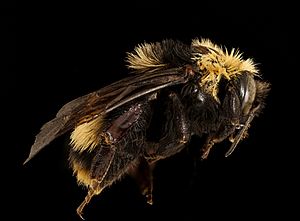Bombus crotchii facts for kids
Quick facts for kids Bombus crotchii |
|
|---|---|
 |
|
| Conservation status | |
| Scientific classification | |
| Genus: |
Bombus
|
| Species: |
crotchii
|
| Synonyms | |
|
|
Bombus crotchii, also known as Crotch's bumblebee, is a type of bumblebee. It was named after an insect expert called George Robert Crotch. This bumblebee is now in danger of disappearing. This is happening because of things like pesticides, changes in the weather, and new buildings.
Contents
What Crotch's Bumblebee Looks Like
Crotch's bumblebee has a short or medium-sized tongue. It can sometimes look like other bumblebees, such as Bombus caliginosus or Bombus occidentalis.
Male Crotch's bumblebees are usually seen from May to September. They are most active in July. Worker bees are busy from April to August, with their busiest time in May and June. Queen bees are active for only two months, from March to May, and are most active in April.
All Crotch's bumblebees have a square-shaped face. They also have a rounded ankle on their middle leg. Bumblebee bodies have parts called segments, numbered T1 to T6.
Female Bumblebees (Queens and Workers)
Female Crotch's bumblebees, both queens and workers, have a black head and face. Their middle and lower body parts are black. The area between their wings is also black.
The first body segment (T1) is all black or black in the middle. The second segment (T2) is usually yellow. Sometimes, it has a black spot in the middle. Segments T3 to T5 are black or orange. The last segment (T6) is black.
Queens and workers look similar. The main difference is their size. Queens are about 23-24 millimeters long. Workers are smaller, about 14-18 millimeters long.
Male Bumblebees (Drones)
Male Crotch's bumblebees, called drones, look a bit different from females. They have yellow hair on their faces. They also have a black stripe in the middle of their body.
The front part of a male's body is yellow. The rest of their body is mostly black and red. Male bodies are shorter than female and queen bodies.
Where Crotch's Bumblebee Lives
This bumblebee mostly lives in California in the United States. You can find it in places like the Pacific coast and the great valley. It also lives in Baja California, Mexico, but it is not very common there.
Crotch's bumblebee was first seen in Nevada in 2003. However, most of these bees are found in the coastal areas of southern California.
We do not know exactly where these bumblebees spend the winter. But experts think they hide under leaves or in soft soil, just like other bumblebees.
Crotch's bumblebee likes grassland and scrub areas. It needs a hotter and drier place than other bumblebee types. It can only live in a very specific kind of weather. This bumblebee builds its nests underground. They often use old dens made by small animals like rodents. Crotch's bumblebee does not move to different places during the year.
What Crotch's Bumblebee Eats
Crotch's bumblebee eats nectar and pollen from many different plants. Some of its favorite food plants include milkweeds, dustymaidens, lupines, medics, phacelias, and sages. It also eats from snapdragons, Clarkia, poppies, and wild buckwheats.
Milkweed is a very popular food source for Crotch's bumblebee. Because bumblebees help pollinate plants, other insects like monarch butterflies also benefit. Since Crotch's bumblebee eats from many different plants, it is called a "dietary generalist." This means it is not picky about its food.
Why Crotch's Bumblebee Needs Our Help
Crotch's bumblebee is an endangered species. This means it is at risk of disappearing forever. In 2014, experts said it was endangered. In 2019, they said it was in even more danger.
The number of Crotch's bumblebees has dropped a lot. They used to be common in the Central Valley of California, but now they are rare there. One group, the Xerces Society, says that the number of these bumblebees has gone down by 98% in the last ten years.
Threats to Crotch's Bumblebee
Many things are causing this bumblebee to disappear:
- Building and Farming: More cities and farms mean less natural space for the bees.
- Climate Change: This bumblebee needs a very specific hot and dry climate. As the weather changes, it becomes harder for them to survive.
- Pesticides: Chemicals used to kill pests, especially neonicotinoids, are very harmful to bumblebees. These chemicals can hurt the bees for many months.
- Inbreeding: As the number of bees gets smaller, they might start breeding with close relatives. This can make them less healthy and less able to survive.
Efforts to Protect the Bumblebee
Groups like the Xerces Society and Defenders of Wildlife are working to protect Crotch's bumblebee. In 2018, they asked the California Fish and Game Commission to list Crotch's bumblebee as endangered. This would give the bee special protection under the California Endangered Species Act.
In 2019, the California Department of Fish and Wildlife agreed that there was enough information to consider protecting the bumblebee.
On June 12, 2019, the California Fish and Game Commission voted on this request. They decided that insects, including bumblebees, could be protected under the act. This was a big step because no insect had ever been protected this way before. This decision is very important because Crotch's bumblebee needs help to survive.
See also
 In Spanish: Abejorro de Crotch para niños
In Spanish: Abejorro de Crotch para niños


